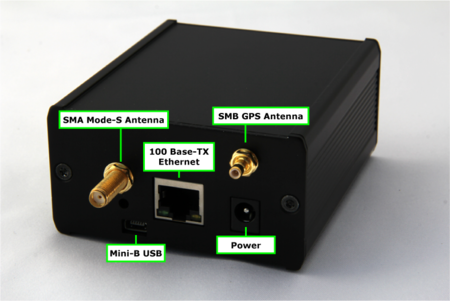Radarcape:Installation Guide: Difference between revisions
imported>Beastadmin |
No edit summary |
||
| (78 intermediate revisions by 4 users not shown) | |||
| Line 1: | Line 1: | ||
= | {{#seo: | ||
|title=Radarcape Installation Guide | |||
|titlemode=replace | |||
|keywords=radarcape,installation,guide,help,support | |||
|description=How to install and configure the Radarcape | |||
}} | |||
{| | |||
|[[File:Beginner.png|For Beginners]] | |||
|''Required computer skills to execute these tasks: Beginner'' | |||
|} | |||
__TOC__ | |||
=Radarcape Hardware Installation= | |||
[[File:Radarcape-back.png|450px|Radarcape backside explained]] | |||
Plug the following connectors into the Radarcape: | |||
* Mode-S antenna | |||
* GPS antenna | |||
* Ethernet/LAN cable | |||
* Power cable | |||
Connect the power supply with the electrical outlet. | Connect the power supply with the electrical outlet. | ||
= | =Mode-S-Antenna Placement= | ||
The Mode-S antenna should be placed as free and as high as possible. | |||
Make sure the Mode-S antenna has a conductive connection with protective ground. Otherwise, static electricity may cause damage to your Radarcape. | |||
==GPS Antenna Placement== | |||
The GPS antenna should be placed to a point with at least half of the sky in free sight, for example a window sill. Some users reported running the GPS antenna indoors. This is not guaranteed to work. | |||
=First time access to the web interface= | |||
The typical way to access the device is via a Ethernet connection to a Router/Switch. | |||
If your network have DHCP enabled your device will obtain a IP address automatically. | |||
If your network does not have DHCP enable, continue to USB network access. | |||
After connecting the device you should be able to access it from a Web Browser at http://radarcape or http://radarcape.local. If you have a Air!Squitter use http://air-squitter or http://air-squitter.local. | |||
If you are unsuccessful accessing by name you need to find the IP address of the device. | |||
To find the IP address you should access your DHCP server assignment table (for example at your local Home Gateway/Router or by contacting your Network administrator), or by using a mDNS/Bonjour smartphone app (eg. [https://play.google.com/store/apps/details?id=de.wellenvogel.bonjourbrowser Bonjour Browser]). | |||
Additionally on the Air!Squitter you can use the [[Radarcape:OLED_display|front panel OLED display]] to check the assigned IP address. | |||
=USB network access= | |||
'''NOTE: you need a Debian 10 image to use this feature''' | |||
The Radarcape/Air!Squitter exposes a USB RNDIS network interface, compatible with typical Linux Distributions and Windows 7 and Windows 10. | |||
Plug the device into your computer and access it from a Web Browser at http://192.168.73.1 | |||
=Wi-Fi Access Point Access= | |||
With the Air!Squitter in addition you can use the Wi-Fi Access Point Mode and connect over Wi-Fi with a smartphone or computer. To enable the Wi-Fi Access Point use the [[Radarcape:OLED_display|front panel OLED display]]. After enabling you can connect to the device with a Web Browser at http://192.168.73.1. | |||
=Login to the Radarcape/Air!Squitter Web Interface= | |||
The default credentials for the device web interface are: | |||
* User: Administrator | |||
* Password: radarcape | |||
'''NOTE: the password is also radarcape for the Air!Squitter''' | |||
We strongly recommend you to '''change your password''' after the first login! For that select ''Configuration'' > ''Change Password'' in the Web configuration menu. | |||
Latest revision as of 15:53, 20 November 2019

|
Required computer skills to execute these tasks: Beginner |
Radarcape Hardware Installation
Plug the following connectors into the Radarcape:
- Mode-S antenna
- GPS antenna
- Ethernet/LAN cable
- Power cable
Connect the power supply with the electrical outlet.
Mode-S-Antenna Placement
The Mode-S antenna should be placed as free and as high as possible.
Make sure the Mode-S antenna has a conductive connection with protective ground. Otherwise, static electricity may cause damage to your Radarcape.
GPS Antenna Placement
The GPS antenna should be placed to a point with at least half of the sky in free sight, for example a window sill. Some users reported running the GPS antenna indoors. This is not guaranteed to work.
First time access to the web interface
The typical way to access the device is via a Ethernet connection to a Router/Switch.
If your network have DHCP enabled your device will obtain a IP address automatically.
If your network does not have DHCP enable, continue to USB network access.
After connecting the device you should be able to access it from a Web Browser at http://radarcape or http://radarcape.local. If you have a Air!Squitter use http://air-squitter or http://air-squitter.local.
If you are unsuccessful accessing by name you need to find the IP address of the device.
To find the IP address you should access your DHCP server assignment table (for example at your local Home Gateway/Router or by contacting your Network administrator), or by using a mDNS/Bonjour smartphone app (eg. Bonjour Browser).
Additionally on the Air!Squitter you can use the front panel OLED display to check the assigned IP address.
USB network access
NOTE: you need a Debian 10 image to use this feature
The Radarcape/Air!Squitter exposes a USB RNDIS network interface, compatible with typical Linux Distributions and Windows 7 and Windows 10.
Plug the device into your computer and access it from a Web Browser at http://192.168.73.1
Wi-Fi Access Point Access
With the Air!Squitter in addition you can use the Wi-Fi Access Point Mode and connect over Wi-Fi with a smartphone or computer. To enable the Wi-Fi Access Point use the front panel OLED display. After enabling you can connect to the device with a Web Browser at http://192.168.73.1.
Login to the Radarcape/Air!Squitter Web Interface
The default credentials for the device web interface are:
- User: Administrator
- Password: radarcape
NOTE: the password is also radarcape for the Air!Squitter
We strongly recommend you to change your password after the first login! For that select Configuration > Change Password in the Web configuration menu.
